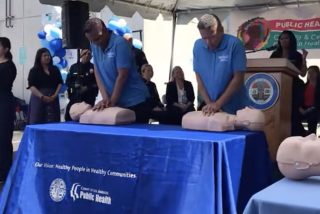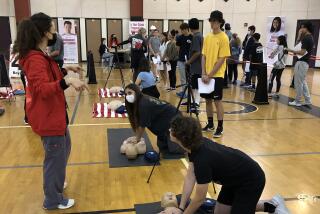Compression-only CPR found effective
- Share via
Chest compressions alone are as effective in rescuing victims of heart attacks as conventional cardiopulmonary resuscitation that combines compressions with forced breathing, researchers said Wednesday.
FOR THE RECORD:
CPR and heart attacks: An article in the July 29 Section A on the relative effectiveness of compression-only cardiopulmonary resuscitation did not properly distinguish between a heart attack and cardiac arrest. CPR should be administered during arrest —that is, when the heart stops pumping blood effectively. A heart attack -- in which blood supply to the heart is blocked -- can cause cardiac arrest. But heart attacks do not warrant CPR unless cardiac arrest occurs.
Studies in Washington and Sweden confirm the growing idea that the breathing component of CPR is necessary only for children and those who have suffered drowning or who have respiratory problems. Recent guidelines based on these and earlier studies may overcome some of the fears of bystanders who are reluctant to initiate CPR because of the danger of infectious diseases.
“These studies reinforce the message that the American Heart Assn. has been promoting since 2008,” said Dr. Michael Sayre, a professor of emergency medicine at Ohio State University in Columbus and a spokesman for the heart association. “When you encounter a person who has collapsed suddenly, the best thing to do is to call 911 and then push hard and fast on their chest. It’s simple, and something anyone can do even if they don’t have any training.”
Communities that are already using the new approach are seeing dramatic increases in survival of people who experience heart attacks, said Dr. Paul E. Pepe, head of the emergency medicine department of the University of Texas Southwestern Medical School in Dallas. Several years ago, Pepe incorporated the findings into guidelines prepared for the National Academies of Emergency Dispatch.
In smaller communities around Dallas that have been able to implement the guidelines quickly, survival rates have as much as quadrupled, Pepe said. In Dallas itself, which has been slower to implement them because of its size, survival has increased by as much as 60%.
The national average survival rate for heart attacks outside the hospital is about 4% or less, Pepe said, and only a quarter to a third of those who could survive are actually getting CPR, so significant numbers of people could be saved if CPR were used more widely.
Studies in animals have shown that halting chest compressions to blow air into the patient’s mouth reduces blood flow by a startlingly large amount. And the breathing drill, in any case, may not be necessary: For most patients who suffer a heart attack, the blood will contain some oxygen for at least several minutes.
“What we have learned is that continuous blood flow, even if it is not fully [oxygen-] saturated, is probably much better in terms of helping restore spontaneous circulation,” Pepe said.
The two new studies, published in the New England Journal of Medicine, were similar in design. In one, conducted by Dr. Thomas D. Rea of the University of Washington in Seattle and his colleagues, 1,941 heart attack victims were included. In the second, conducted by Dr. Marten Rosenqvist of the Karolinska Institutet of Stockholm, 1,276 victims were studied.
In both cases, 911 operators randomly instructed callers to administer either conventional CPR or only chest compressions. Rea and his colleagues found that 12.5% of those given only compressions survived to be discharged from the hospital, compared to 11% of those given conventional CPR. Rosenqvist and colleagues found that the 30-day survival was 8.7% for those given compressions only, compared to 7% for those given conventional CPR.
In neither case were the differences statistically significant.
“Both types of CPR performed by a bystander are beneficial, and the benefit is well above not doing anything,” Rea said. He hopes that the ease of doing compression alone will increase CPR rates up to at least one in two “and therefore save a lot more lives.”






